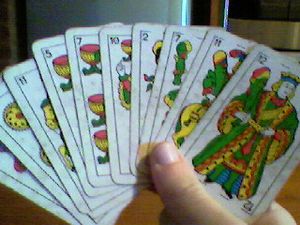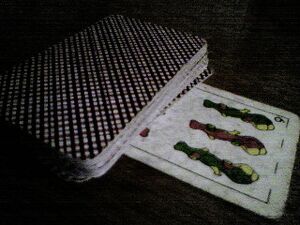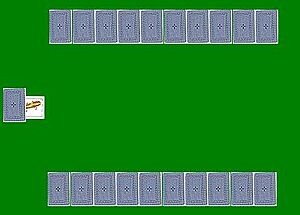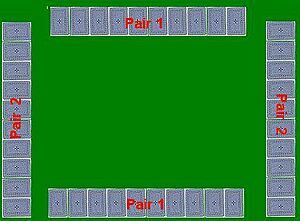Tute facts for kids

A player of Tute holding the ten cards as a fan
|
|
| Origin | Italy |
|---|---|
| Alternative names | Tutti |
| Type | Trick-taking |
| Players | 2 or 4 |
| Skills required | Tactic; Teamwork (Tute in Pairs) |
| Age range | 7+ |
| Cards | 40 cards |
| Deck | Spanish |
| Play | counter-clockwise |
| Card rank (highest to lowest) | 1 3 12 11 10 7 6 5 4 2 |
| Playing time | 8–10 minutes per hand |
| Random chance | Medium |
| Related games | |
| Briscola | |
Tute is a fun card game where players try to win "tricks" (rounds of cards). It's played with two to four people. This game started in Italy in the 1800s, where it was called Tutti. Later, it became super popular in Spain, and people there started calling it Tute.
You play Tute with a special deck of Spanish playing cards. These cards are a lot like the 40-card decks used in Italy. The main goal of the game is to score the most points. You get points by winning tricks and by having certain combinations of cards in your hand. There are a few different ways to play Tute, but the most common are for two players or for four players in teams.
Contents
Discovering Tute's History
Tute began in Italy. It's part of the same family of card games as Briscola, so they share some similar rules. The name Tute comes from the Italian word Tutti, which means "all." Players would shout "Tutti!" if they had all four Kings or all four Jacks.
Spanish soldiers brought the game back to Spain after their missions in Italy during the 19th century. As more and more people played it, the name changed over time to Tute. It became one of Spain's most loved card games, and soon, different versions of Tute popped up in different regions.
The game uses a Spanish deck. This deck has four suits: Oros (Coins), Espadas (Swords), Copas (Cups), and Bastos (Batons). The 8s and 9s are removed from the deck, leaving 40 cards. Your main goal is to score the most points. You do this by winning cards in tricks and by making special "declarations" with certain card combinations.
How to Play Tute
Two-Player Tute: "Tute Habanero"
In this version, each player gets eight cards. The next card from the deck is turned face-up. This card becomes the "trump" card, which is super powerful! It's placed under the rest of the deck, which is called the "stock."
The player who didn't deal the cards starts the first trick. They play any card they want. The second player must try to play a card of the same suit as the first card, and if they can, they should play a higher card.
- If the second player doesn't have a card of the same suit, but they have a trump card, they must play a trump.
- If they have no cards of the same suit and no trumps, they can play any card.
The trick is won by the highest trump card played. If no trumps are played, the highest card of the suit that was led wins.
The player who wins the trick takes both cards. They put these cards face down in a special pile next to them called the baza. These cards stay out of play until the end of the round when you count points.
After winning a trick, the winner takes the top card from the stock. The loser takes the next card. This way, both players always have eight cards in their hand until the stock runs out. The winner of the trick can also make any special announcements (declarations) before playing the next card.
If the face-up trump card is an Ace, Three, King, Knight, or Knave (cards higher than a 7), the player who has the 7 of trumps can swap it for the face-up trump card. Lower trump cards (6, 5, 4) can only be swapped for a 2. You can swap trumps anytime until only two cards are left in the stock.
Once a player wins their first baza, they can start making declarations. You can declare cards until only two cards are left in the stock. After those last two cards are picked up, all the cards in players' hands must be played to finish the game. When the game is over, players count their scores. After counting, all the cards are mixed up for the next game.
Tute in Pairs: Team Play
Tute in Pairs is played by four players. They form two teams of two. Each player gets ten cards, so all 40 cards in the deck are dealt out. The very last card dealt is shown to everyone, and it becomes the trump card. This trump card belongs to the player it was dealt to. Players sit in a circle, with teammates sitting opposite each other.
One player starts by playing a card. The player to their right (from the opposing team) plays next. Just like in two-player Tute, there are rules for what card to play:
- If you have a higher card of the same suit as the first card, you must play it.
- If you have a card of the same suit, but only lower ones, you must play one of those.
- If you don't have any cards of the same suit, but you have a trump card, you must play a trump.
- If you have no cards of the same suit and no trumps, you can play any card.
The next two players follow the same rules. When all four cards are on the table, the team that played the strongest card wins the trick. Trump cards are the strongest, followed by the suit that was led first. The ranking of cards from strongest to weakest is: Ace, 3, King, Knight, Knave, 7, 6, 5, 4, 2.
The winning team puts the four cards from the trick into their baza. Rules for declarations are similar to two-player Tute. However, in pairs, you must declare your cards after your team wins its first baza. Only the team that is currently winning tricks can declare. If the other team starts winning tricks, they can then declare. After all cards are played, teams count their scores. The cards are then mixed up for the next round, and the dealing moves to the next player to the right.
Scoring Points in Tute
Tute games are played until one player or team reaches a certain number of "game points." Usually, games are played to three or six game points. Each time a player or team wins a round, they get one game point. The first to reach the goal wins the whole game!
To win a round, you need to get the most "round points." These points come from the cards you collect in your baza, bonus points from declarations, and a bonus for winning the last trick.
Card Values
Not all cards are worth points! Here's how cards are valued:
| Card |  |
 |
 |
 |
 |
| Name | As (Ace) | Tres (Three) | Rey (King) | Caballo (Knight) | Sota (Knave) |
| Value (points) | 11 Points | 10 Points | 4 Points | 3 Points | 2 Points |
The other cards (7, 6, 5, 4, 2) are called cartas blancas (white cards) because they are worth zero points.
Declarations: Bonus Points!
If a player or team wins at least one trick, they can earn extra "round points" by declaring special card combinations.
- If you have all four Kings, you can declare tute (all)! This automatically wins you the entire round.
- If you have both the King and Knight of the trump suit, you can declare las cuarenta (forty). This gives you an extra 40 round points.
- If you have the King and Knight of any other suit, you can declare veinte (twenty). This adds 20 round points to your score.
You can declare several combinations if you have them. Always declare the combination with the highest point value first. For example, if you declare veinte, you can't then declare las cuarenta in the same turn. However, in two-player games, if you pick up a card from the stock that completes a higher declaration, you can declare it in a later turn.
Your total round points are the sum of the points from the cards in your baza plus any points from your declarations. The player or team who wins the very last trick also gets a bonus of 10 round points! The most points you can get in a round is 230 points.
| Points from Cards in Baza | Declarations | Last Trick Won | Total | ||||||
|---|---|---|---|---|---|---|---|---|---|
| Card Rank | Knaves | Knight | King | Three | Ace | Las cuarenta! | Veinte | ||
| Amount | 2 | 0 | 1 | 3 | 2 | 1 | 0 | 1 | 110 |
This example shows how points add up: 2 Knaves (2x2=4), 0 Knights (0x3=0), 1 King (1x4=4), 3 Threes (3x10=30), 2 Aces (2x11=22). Plus one "Las cuarenta" (40 points) and the last trick bonus (10 points). Total: 4+0+4+30+22+40+10 = 110 points.
Tute Variations
Because Tute is so popular in Spain, many different versions have popped up! These variations usually have similar rules to the classic Tute, but they might change things like the number of cards used, how declarations work, or other small rules.
See also
 In Spanish: Tute para niños
In Spanish: Tute para niños





